Foot flexion (mycosis) is a fairly common disease, the sign of which is skin damage.
Infection occurs during contact of healthy skin with a spore carrier, as well as through the home route: through shoes, shared bathroom and contaminated items. The fungal infection easily penetrates into the interdigital folds (under favorable conditions), where it begins its path and population growth across the surface of the foot.
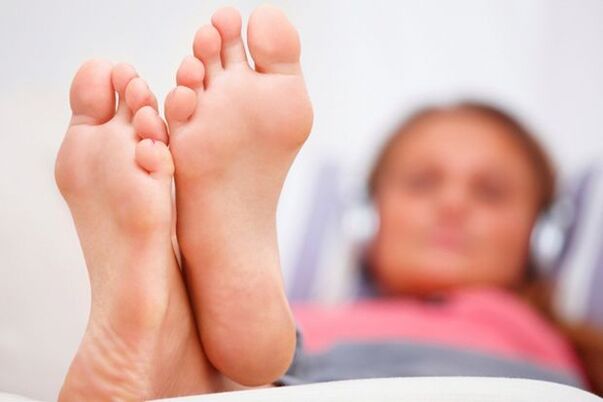
What is a fungus?
Foot mycosis is the most common type of dermatomycosis, which is characterized by chronic relapse. It includes both damage to the layers of skin and nails. The upper layer of the skin, which is constantly peeled, contains a mass of fungi, as well as their spores.
Fungi are a contagious disease that is transmitted from person to person through household items. Intra-digital folds are the first to be affected, due to which itching occurs. After that, the infection covers the entire foot area. The disease develops rapidly and is characterized by the presence of itching, burning, pain, dry skin, peeling and even diaper rash.
Reasons for submission
The main cause of the disease are microorganisms of the genus Trichophyton, as well as fungi. Infection with them occurs in the following conditions:
- wearing tight shoes (when the feet are tightened, cracks and sores are created, in which the infection develops easily);
- excessive sweating of the feet (this is an excellent environment for the development of the fungal population);
- with high humidity in the room (shower, bath) - favorable conditions for all types of fungi;
- frequent visits to saunas, swimming pools (increases the risk of contact with carriers of the infection);
- the presence of a sick person in the family (you can be infected through household items: slippers, socks and a shared bathroom).
There are also a number of diseases in which a person is susceptible to fungal infection:
- lack of immunity (a weakened immune system is more susceptible to infectious and bacterial diseases);
- taking hormonal drugs (violates hormonal levels);
- flat feet (with this disease it is difficult to choose shoes with the right lift, often the feet are squeezed);
- varicose veins (poor circulation causes dry skin);
- atherosclerosis;
- diabetes mellitus (there is an increase in capillary permeability, a change in their obstructive function).
Symptoms
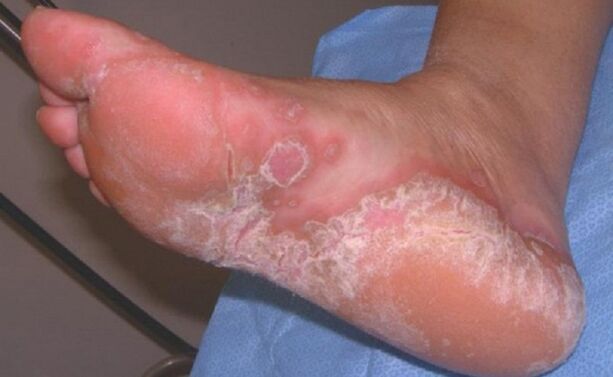
The main symptoms of foot mycosis are:
- burning and itching between the toes of the lower extremities (in the initial form) and on the entire surface of the feet (in the later stages);
- painful sensations (of varying intensity: the pain may increase, then disappear completely for a short time);
- skin rash (from a light pink to purple tinge);
- abundant dryness and discoloration (separation of scales and crust from plates);
- cracks in the skin of the feet (which do not go away with ordinary moisturizers);
- changes in the color and structure of the nails (they become thick and melt);
- the presence of an unpleasant foot odor (if not previously noticed).
Important!
With a fungal infection, the usual hygiene procedures (foot washing, pumice and steaming) give no results, the symptoms do not go away!
Why should fungus be treated?
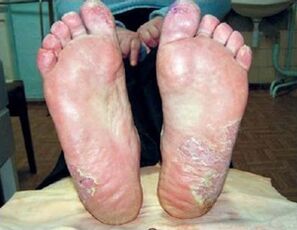
The success of therapy depends on the accuracy of the diagnosis and the identification of the exact type of causative agent of foot mycosis. Regardless of the form and stage of the fungal infection, an integrated approach to treatment is used.
Without a competent approach to treatment, the fungus will not go anywhere, it is not a disease that goes away on its own.
After all, the remnants of parasitic fungi will spread to the surrounding tissues and enter the bloodstream, poisoning it, and this is an allergen for the human body (eczema can even develop).
In addition, a person infected with a fungus is a source of infection and is a danger to others. Ultimately, the infection occurs through household items and through contact with the skin of the carrier of the infection.
Mushroom shapes
In total, there are 6 forms of this fungal foot lesion:
- Deleted form. This is the initial form, it varies in the following manifestations: light skin in interdigital folds and small superficial cracks, which do not cause discomfort.
- Squamous form. Presence of small scales between the toes and on the surface of the foot. There are no signs of inflammation other than slight itching.
- Hyperkeratotic form. The appearance of blue-red plaques (papules), which are located on the arches of the legs. Dry skin, moderate pain and itching are noticed.
- Intermediate forms. Looks similar to diaper rash. The skin on the interdigital folds becomes bright red, swelling and tearing tears appear, and even erosion may be present. Pain, burning and itching complete the look.
- Dyshidrotic form. The appearance of bubbles is noticed, which are closed from above with a dense lid. They are localized in the arches of the feet and are characterized by severe itching.
- Acute form. The skin of the feet is covered with vesicles and blisters with purulent-serous contents, their opening leads to numerous erosions and deep cracks. Body temperature rises significantly, the skin of the feet is bright red, there is severe pain, difficulty walking, headaches and general weakness. Inguinal lymphadenitis develops.
Diagnosis of viruses
Diagnosis of the disease is performed by a dermatologist or mycologist (this depends on the area and extent of the fungal infection) and is based on the detection of a fungus when skin scales are examined under a microscope.
The skin is taken from the affected area of the foot with itching, after which it is treated with special reagents. In the process of examining it under a microscope, a specialist determines the type of pathogen, or grows the fungus in a nutrient medium (it is easier to determine its type from a growing population).
Treatment methods
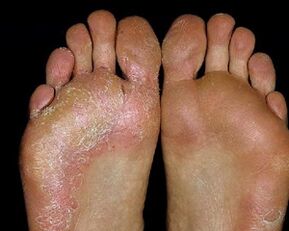
The basic rule in the treatment of foot fungus is an integrated approach, which includes not only the use of medication, the use of alternative treatment methods, but also the careful care of the affected skin.
Before starting drug therapy, you should consult a doctor who will identify the pathogen using laboratory tests. Foot mycosis should be treated under the close supervision of a physician or in a hospital setting. The therapy is performed in 2 phases: preparatory and basic.
The first involves eliminating the inflammation as well as removing the stratum corneum using pre-evaporation of the feet in a solution of potassium permanganate and boric acid.
The second stage involves drug treatment.
Treatment with drugs (ointments, creams, tablets, other drugs)
After removing the keratinized upper cells, a special cream with antibiotics and corticosteroid hormones is applied to the entire affected area. After eliminating the inflammation, the foot baths are canceled. Further treatment consists of deep removal of the horny layers using salicylic Vaseline.
It is applied in a thin layer at the site of the lesion until the corneal particles are completely detached. Immunity-boosting therapy is also effective: taking immunomodulators and vitamin complexes, because the stronger the body's defense system, the faster the disease passes.
Important!
The use of ointments is prohibited! They can cause weeping erosion.
Treatment with folk remedies for this disease can only be an adjunct therapy, and not the main method of treatment.
Folk remedies
Treatment should be systematic and include not only medications but also folk remedies:
- Apple cider vinegar is considered the best such recipe because mushrooms do not like acidic environment. The method of application is quite simple - apply a vinegar solution on the affected area (concentration is selected individually), wear socks and go to bed.
- Laundry soap and baking soda is another effective method. You need to grind 3 tablespoons of soap and add the same amount of baking soda. Pour this mixture with hot water (at least 5 liters), lower the legs there for 15-20 minutes. After the procedure, clean the feet with a nail file or pumice stone.
- Also, significant results are shown by glycerin with vodka. It is necessary to fill the bottle of purchased glycerin with alcohol to the brim, shake it and moisturize the skin with this composition every day (before bedtime).
- Coffee is effective in the fight against fungal infections. You need to create strong coffee, soak your feet in the drink until cool. It is recommended to do this procedure for at least a week.
- Celandine is also a good helper for fungal infections. You need to pour 1 liter of water into the kettle, put it on the stove, boil it and add 4 tablespoons. l. herb (boiled for 5 minutes). In the resulting infusion, you need to lift your legs for 3 weeks a day.
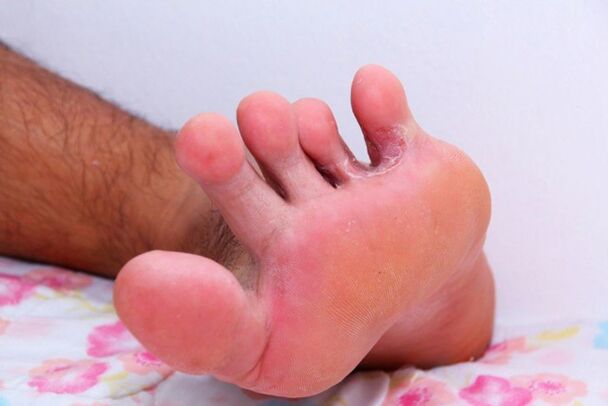
How to cure fungus in a child?
Treatment of mycosis in children occurs in several stages:
- steamed feet (in a solution of baking soda and laundry soap, or with the addition of apple cider vinegar, you can also use chamomile soup - an excellent antiseptic);
- removal of keratinized particles (with a pumice stone or a stiff cloth, rub the cracked surface until the upper layer of the epidermis is peeled off);
- treatment with 2% iodine of the affected area promotes healing and disinfects well (you can apply an iodine mesh to the infected skin);
- before going to bed, apply a cream based on miconazole and nystatin (they are safe for children and quite effective) and wear cotton socks (or special antibacterial ones).
Disease prevention
Preventive measures are quite simple and include the following points:
- Compliance with personal hygiene rules (especially when visiting public swimming pools, baths and saunas). It is necessary to move with slippers, not to become barefoot on the floor and not to wear someone else's shoes.
- When visiting, you should also give up slippers and walk inside in socks.
- Wash your feet with antimicrobial soap and a washcloth every day before bed.
- Be sure to dry your feet after washing (especially between the toes).
- When keratinized cells appear, they should be treated with a pumice stone and scissors or nipples.
- You need to trim your nails in time, preventing them from distorting.
- If there are cracks in the feet, you should use special gels and lotions.
- Wearing tight shoes is not allowed because it impairs blood circulation.
- In case of wounds and scratches on the skin of the feet, it is necessary to treat them with shiny green.
- With increased foot sweating, it is necessary to use special sprays and gels (not sold in any pharmacy).
Conclusion
Mycosis of the feet is an insidious disease that not only causes unpleasant sensations and spoils the appearance of the skin and nails, but can also cause eczema as well as decreased immunity. In order not to be infected with the fungus, it is necessary to observe the basic standards of hygiene.
Well, in case of infection - urgently seek advice from a specialist who will diagnose and prescribe effective treatment. Mycosis is easy to defeat if treatment is started on time.
















